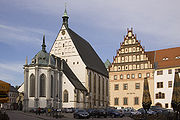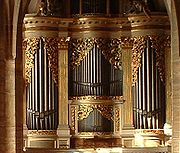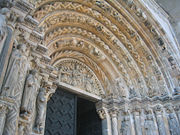
Freiberg Cathedral
Encyclopedia

Evangelical Church in Germany
The Evangelical Church in Germany is a federation of 22 Lutheran, Unified and Reformed Protestant regional church bodies in Germany. The EKD is not a church in a theological understanding because of the denominational differences. However, the member churches share full pulpit and altar...
church in Freiberg, Saxony
Freiberg, Saxony
Freiberg is a city in the Free State of Saxony, Germany, administrative center of the Mittelsachsen district.-History:The city was founded in 1186, and has been a center of the mining industry in the Ore Mountains for centuries...
. It is called a cathedral in English even though it has never been the seat of a bishop.
History
Around 1180, the basilicaBasilica
The Latin word basilica , was originally used to describe a Roman public building, usually located in the forum of a Roman town. Public basilicas began to appear in Hellenistic cities in the 2nd century BC.The term was also applied to buildings used for religious purposes...
"of our Lady" was built in Freiberg, which was developing rapidly due to the silver
Silver
Silver is a metallic chemical element with the chemical symbol Ag and atomic number 47. A soft, white, lustrous transition metal, it has the highest electrical conductivity of any element and the highest thermal conductivity of any metal...
that had recently been found in the Ore Mountains. Two significant works of art that are still conserved were added very early: the Triumphkreuzgruppe crucifixion group (around 1225) and the Goldene Pforte (Golden Gate). In 1480, the church was turned into a Collegiate church
Collegiate church
In Christianity, a collegiate church is a church where the daily office of worship is maintained by a college of canons; a non-monastic, or "secular" community of clergy, organised as a self-governing corporate body, which may be presided over by a dean or provost...
. However, the collegiate was dissolved after only 57 years due to the reformation
Protestant Reformation
The Protestant Reformation was a 16th-century split within Western Christianity initiated by Martin Luther, John Calvin and other early Protestants. The efforts of the self-described "reformers", who objected to the doctrines, rituals and ecclesiastical structure of the Roman Catholic Church, led...
in Saxony
Saxony
The Free State of Saxony is a landlocked state of Germany, contingent with Brandenburg, Saxony Anhalt, Thuringia, Bavaria, the Czech Republic and Poland. It is the tenth-largest German state in area, with of Germany's sixteen states....
.

Nave
In Romanesque and Gothic Christian abbey, cathedral basilica and church architecture, the nave is the central approach to the high altar, the main body of the church. "Nave" was probably suggested by the keel shape of its vaulting...
d Gothic
Gothic architecture
Gothic architecture is a style of architecture that flourished during the high and late medieval period. It evolved from Romanesque architecture and was succeeded by Renaissance architecture....
hall church
Hall church
A hall church is a church with nave and side aisles of approximately equal height, often united under a single immense roof. The term was first coined in the mid-19th century by the pioneering German art historian Wilhelm Lübke....
. A remarkable feature are the two adjacent pulpit
Pulpit
Pulpit is a speakers' stand in a church. In many Christian churches, there are two speakers' stands at the front of the church. Typically, the one on the left is called the pulpit...
s in the central nave: the free-standing Tulpenkanzel (Tulip pulpit) from 1505, made by sculptor Master H.W. of a light type of the Tuff from Chemnitz
Chemnitz
Chemnitz is the third-largest city of the Free State of Saxony, Germany. Chemnitz is an independent city which is not part of any county and seat of the government region Direktionsbezirk Chemnitz. Located in the northern foothills of the Ore Mountains, it is a part of the Saxon triangle...
-Hilbersdorf and the Bergmannkanzel (Miner's pulpit) of 1638 created by Hans Fritzsche of a Saxonian
Saxony
The Free State of Saxony is a landlocked state of Germany, contingent with Brandenburg, Saxony Anhalt, Thuringia, Bavaria, the Czech Republic and Poland. It is the tenth-largest German state in area, with of Germany's sixteen states....
sandstone
Sandstone
Sandstone is a sedimentary rock composed mainly of sand-sized minerals or rock grains.Most sandstone is composed of quartz and/or feldspar because these are the most common minerals in the Earth's crust. Like sand, sandstone may be any colour, but the most common colours are tan, brown, yellow,...
.

Interior
Between 1541 and August II the Strong's conversion to Catholicism, nine rulers of SaxonyRulers of Saxony
This article lists Dukes, Electors, and Kings ruling over different territories named Saxony from the beginning of the Saxon Duchy in the 9th century to the end of the Saxon Kingdom in 1918.-Dukes of Saxony:...
were buried in the quire
Quire (architecture)
Architecturally, the choir is the area of a church or cathedral, usually in the western part of the chancel between the nave and the sanctuary . The choir is occasionally located in the eastern part of the nave...
of the cathedral. August's mother and her sister are buried in the sisters' crypt in the All Saints chapel. Their tomb, created by the Saxon Baroque sculptor Balthasar Permoser
Balthasar Permoser
Balthasar Permoser was among the leading sculptors of his generation, whose evolving working styles spanned the late Baroque and early Rococo....
, had originally been situated in the Lichtenburg
Lichtenburg
Lichtenburg is a proper noun referring to:*Lichtenburg, a city in the North West Province of South Africa*Lichtenburg, a Nazi concentration camp in eastern Germany...
at Prettin
Prettin
Prettin is a town and a former municipality in Wittenberg district in Saxony-Anhalt. Since 1 January 2011, it is part of the town Annaburg. It was part of the former administrative community of Annaburg-Prettin....
, but was moved to Freiberg in 1811. Another noteworthy feature is the monument honoring Maurice, Elector of Saxony
Maurice, Elector of Saxony
Maurice was Duke and later Elector of Saxony. His clever manipulation of alliances and disputes gained the Albertine branch of the Wettin dynasty extensive lands and the electoral dignity....
, who also is buried in the Freiberg Cathedral.
Several monumental brass
Monumental brass
Monumental brass is a species of engraved sepulchral memorial which in the early part of the 13th century began to partially take the place of three-dimensional monuments and effigies carved in stone or wood...
es form the floor of the quire. The walls are decorated with a wealth of epitaph
Epitaph
An epitaph is a short text honoring a deceased person, strictly speaking that is inscribed on their tombstone or plaque, but also used figuratively. Some are specified by the dead person beforehand, others chosen by those responsible for the burial...
s and sculpture
Sculpture
Sculpture is three-dimensional artwork created by shaping or combining hard materials—typically stone such as marble—or metal, glass, or wood. Softer materials can also be used, such as clay, textiles, plastics, polymers and softer metals...
s of the ducal house. The design of the ceiling is a combination of painting and sculpture in the style of Italian
Italy
Italy , officially the Italian Republic languages]] under the European Charter for Regional or Minority Languages. In each of these, Italy's official name is as follows:;;;;;;;;), is a unitary parliamentary republic in South-Central Europe. To the north it borders France, Switzerland, Austria and...
mannerism
Mannerism
Mannerism is a period of European art that emerged from the later years of the Italian High Renaissance around 1520. It lasted until about 1580 in Italy, when a more Baroque style began to replace it, but Northern Mannerism continued into the early 17th century throughout much of Europe...
. The transition between wall and ceiling is formed by a multitude of musical angel
Angel
Angels are mythical beings often depicted as messengers of God in the Hebrew and Christian Bibles along with the Quran. The English word angel is derived from the Greek ἄγγελος, a translation of in the Hebrew Bible ; a similar term, ملائكة , is used in the Qur'an...
s on the uppermost ledge of the epitaph architecture. Analysis has shown that the instruments used are real Renaissance
Renaissance
The Renaissance was a cultural movement that spanned roughly the 14th to the 17th century, beginning in Italy in the Late Middle Ages and later spreading to the rest of Europe. The term is also used more loosely to refer to the historical era, but since the changes of the Renaissance were not...
instruments or excellent imitations. This was very useful, since no other instruments of this time were extant. These finds were examined in Leipzig
Leipzig
Leipzig Leipzig has always been a trade city, situated during the time of the Holy Roman Empire at the intersection of the Via Regia and Via Imperii, two important trade routes. At one time, Leipzig was one of the major European centres of learning and culture in fields such as music and publishing...
, and replicas were built. Even the imitations were detailed enough to serve as a blueprint for replicas, and these instruments were relevant to allow the reproduction of the typical sound of an orchestra of the time.
A special attraction for organ
Pipe organ
The pipe organ is a musical instrument that produces sound by driving pressurized air through pipes selected via a keyboard. Because each organ pipe produces a single pitch, the pipes are provided in sets called ranks, each of which has a common timbre and volume throughout the keyboard compass...
enthusiasts is the great organ by Gottfried Silbermann
Gottfried Silbermann
Gottfried Silbermann was an influential German constructor of keyboard instruments. He built harpsichords, clavichords, organs, and fortepianos; his modern reputation rests mainly on the latter two.-Life:...
with its three keyboards
Musical keyboard
A musical keyboard is the set of adjacent depressible levers or keys on a musical instrument, particularly the piano. Keyboards typically contain keys for playing the twelve notes of the Western musical scale, with a combination of larger, longer keys and smaller, shorter keys that repeats at the...
, 44 organ stop
Organ stop
An organ stop is a component of a pipe organ that admits pressurized air to a set of organ pipes. Its name comes from the fact that stops can be used selectively by the organist; some can be "on" , while others can be "off" .The term can also refer...
s and 2574 organ pipe
Organ pipe
An organ pipe is a sound-producing element of the pipe organ that resonates at a specific pitch when pressurized air is driven through it. Each pipe is tuned to a specific note of the musical scale...
s. Opposite of it is another, smaller Silbermann organ, which is also an excellent instrument.
The cathedral has six church bell
Church bell
A church bell is a bell which is rung in a church either to signify the hour or the time for worshippers to go to church, perhaps to attend a wedding, funeral, or other service...
s, four of which are from the famous Hilliger casting house. The heaviest of the bells is the Große Susanne at 5 tons.

Romanesque architecture
Romanesque architecture is an architectural style of Medieval Europe characterised by semi-circular arches. There is no consensus for the beginning date of the Romanesque architecture, with proposals ranging from the 6th to the 10th century. It developed in the 12th century into the Gothic style,...
arched sandstone
Sandstone
Sandstone is a sedimentary rock composed mainly of sand-sized minerals or rock grains.Most sandstone is composed of quartz and/or feldspar because these are the most common minerals in the Earth's crust. Like sand, sandstone may be any colour, but the most common colours are tan, brown, yellow,...
portal on the southern side of the cathedral, adorned by sculptures and richly ornamented columns that were originally richly colorated. To protect the gate from environmental influences, an extension was built in 1902/03.
The cathedral is still used for services by the congregation. It can be visited daily for a fee in guided tours.

